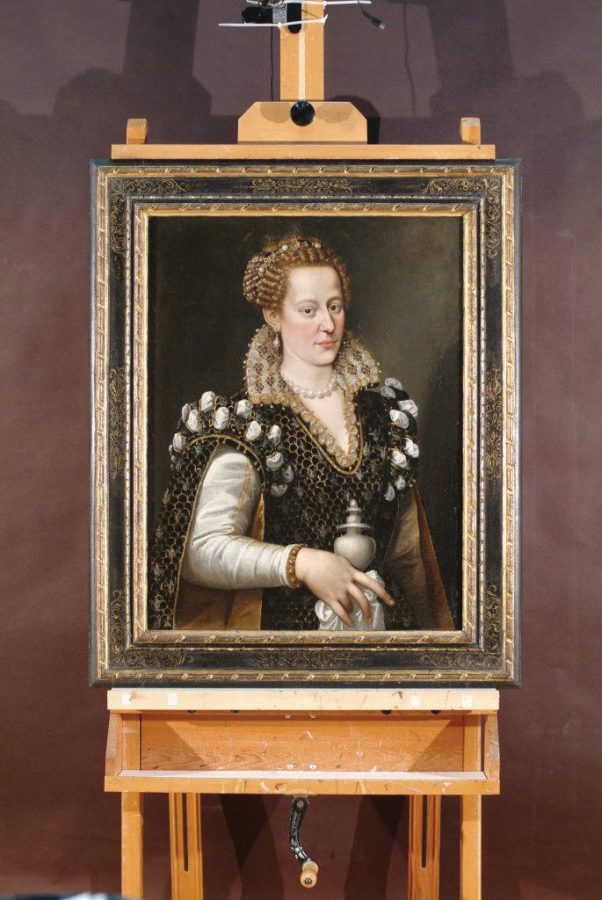Welcome Back: Carnegie exhibit explores restoration of Renaissance art
August 19, 2014
To curator Lulu Lippincott, the portrait of a woman in Renaissance finery had always seemed oddly patched together. A neutral face that seemed too perfect for its own good stares out from the sumptuous frills and golden cords that dress her.
This portrait — attributed to Italian Renaissance painter Agnolo Bronzino, now known to depict Isabella de’ Medici — is one of the four works on display in the Carnegie Museum of Art’s exhibition “Faked, Forgotten, Found,” which is on display until Sept. 15.
“Faked, Forgotten, Found” is a tribute to the behind-the-scenes work that goes on in museums, with a specific emphasis on the attempt to expose the mysteries of art.
The exhibition is set up as a sort of timeline that shows the steps of the investigation, with a peek into the conservation process. In the rotunda, the paintings are displayed to show the conservators’ discoveries.
Each painting has its own tale of intrigue, mystery and awe that rivals Dan Brown for suspense.
Ellen Baxter, chief conservator at the CMoA, was part of the team that examined the paintings on display.
It was only until the Carnegie’s routine inspection of their collection and a call for deaccession — when curators determine which works will remain in a collection and which will go — that anyone paid attention to the portrait attributed to Bronzino.
Lippincott went into the bowels of the museum to examine and weed out outliers in the collection.
“I went to find ugliest and most terrible painting in the collection, and it was the supposed-Bronzino that I chose,” she said.
Lippincott handed it over to Baxter to see if it could be de-accessioned and, upon closer examination, Baxter found cracks and a stamp on the flipside of the canvas.
“These kinds of markings identified the work as having been relined” Baxter said.
In a relined work, the original canvas is re-pasted to a new one. With the supposed-Bronzino, it signified that something was amiss.
As Baxter continued her work, she found a surprise behind the dainty hands and the beautiful face of the supposed-Bronzino. An X-ray of the face and hands showed that an older person was behind the youthful Victorian image. A droopier, older face peered out behind the overpainting and the figure sported hands large enough to dribble a basketball.
Baxter and her team discovered that this strange agglomeration was not, as originally believed, a Victorian-era faked Bronzino. Rather, it was a cover-up of a 16th century Renaissance portrait of Isabella de’ Medici by an unknown artist.
Isabella de’ Medici was part of the aristocratic and power-hungry Medici family that not only maintained a stronghold on Florentine society, but who also commissioned some of the finest known works of art.
After her untimely and brutal death at the hands of her own family, it’s believed that the portrait went underground to try and erase the memory of the ill-fated Isabella. Fast-forward to the mid-19th century and the painting had made its way to London, where it was relined to become more marketable.
“They changed it from a Catholic Renaissance image to one that would appeal more to a wider Anglican audience,” Baxter said. “They thinned her neck and overall made her appearance more Victorian and painted out the urn that represented Mary Magdalene, thereby erasing any Catholic connotations.”
Christopher Nygren, a Pitt professor, art historian and specialist in Renaissance and Baroque art, said that many Renaissance-era paintings were “redefined” to make them more appealing.
“Many portraits lose the specific identity of the person depicted through time, so the collector, in order to sell it, would refashion the image,” Nygren said.
Nygren also pointed out the bittersweet nature of this particular deaccession process.
“It is amazing to think that if they had not given thought to get rid of the piece, its real identity may have never been discovered,” he said.
Three more works that display the undercover work of museums accompany the Isabella de’ Medici portrait. One is a restored Holbein painting that shows the amount of grime and tarnish that had to be removed to uncover a lustrous blue background.
Another is a recently attributed Jan Rombouts the Elder work, still under investigation for Holocaust-era art thievery claims.
There is also a juxtaposition of the painting “Madonna and Child with Angel” by Francesco Francia and its faked replica, owned by the National Gallery in London.
“We were really grateful that the National Gallery lent us their copy of the painting and that people can see just how incredibly good these faked works are,” Lippincott said.
Baxter said that they did “a Snoopy dance” when it was discovered that the Carnegie’s was the real one, and that the one that had been in the National Gallery for years was a copy.
The entire exhibition gives the audience an exposé into these curatorial decisions and collaborations.
“It’s important for people to know what goes on in museums,” Lippincott said. “This is the kind of research that can only be done in museums and hopefully it will reassure visitors that the works they see when they visit museums are real.”








